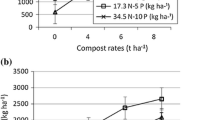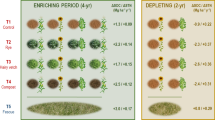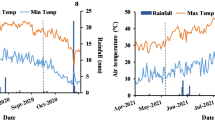Abstract
Throughout the world, compost application is viewed as a long-term strategy to improve the availability of phosphorus (P) for agricultural crops. Limited information is available on the legacy effects of P in compost-amended soils with respect to the subsequent effects of mineral P fertilizer on crop growth. We therefore conducted two cycles of maize growth experiments in pots (replicates; n = 4) under greenhouse conditions, with each cycle lasting 84 days. We used two soils that had been fertilized with compost over the past 10 years. The first cycle of maize growth was carried out under full P fertilization conditions, i.e. 150 mg P kg−1 soil (300 kg P ha−1), as calcium dihydrogen phosphate. The second cycle of maize was grown in the same soil and pots after harvesting the first cycle. Plant and soil measurements included soil Hedley P fractions and plant P uptake. Readily available plant P NaHCO3-Pi ranged from 93 to 221 mg P kg−1, increasing by 31% due to compost and 76% due to Ca-P fertilization compared with no compost or Ca–P fertilization, respectively. However, the application of compost and fertilizer only increased the production of dry matter by 7–9%, and plant P uptake by 11% and 17% compared to previous compost and Ca–P applications, respectively. Compost protected against the depletion of the NaHCO3–Po pool and was therefore helpful to initiating a P legacy stock, enhancing soil resilience and limiting the depletion of P by future crop rotations with high P requirements. However, compost mixed with mineral P provided the best availability of P for both immediate crop requirements and the long-term preservation of soil fertility.



Similar content being viewed by others
References
Ahmad M, Khan MJ, Muhammad D (2013) Response of maize to different phosphorus levels under calcareous soil conditions. Sarhad J Agric 29:43–48
Bhat N, Ria A, Ramesh A, Iqbal S, Sharma M, Sharma S, Bhullar G (2017) Soil biological activity contributing to phosphorus availability in vertisols under long-term organic and conventional agricultural management. Front Plant Sci 8(1523). https://doi.org/10.3389/fpls.2017.01523
Borggaard OK, Raben-Lange B, Gimsing AL, Strobel BW (2005) Influence of humic substances on phosphate adsorption by aluminium and iron oxides. Geoderma 127:270–279. https://doi.org/10.1016/j.geoderma.2004.12.011
Cabeza RA, Myint K, Steingrobe B, Stritsis C, Schulze J, Claassen N (2017) Phosphorus fractions depletion in the rhizosphere of young and adult maize and oilseed rape plants. -P. J Soil Sci Plant Nutr 17:824–838. https://doi.org/10.4067/S0718-95162017000300020
Coelho M, Ruiz Diaz D, Hettiarachchi G, Hansel F, Pavinato P (2019) Soil phosphorus fractions and legacy in a corn-soybean rotation on Mollisols in Kansas, USA. Geoderma Regional 18(2019):e00228. https://doi.org/10.1016/j.geodrs.2019.e00228
Cross A, Schlesinger W (1995) A literature review and evaluation of the Hedley fractionation: Applications to the biogeochemical cycle of soil phosphorus in natural ecosystems. Geoderma 64:197–214. https://doi.org/10.1016/0016-7061(94)00023-4
Dou Z, Ramberg CF, Toth JD, Wang Y, Sharpley AN, Boyd SE, Chen CR, Williams D, Xu ZH (2009) Phosphorus speciation and sorption-desorption characteristics in heavily manured soils. Soil Sci Soc Am J 73:93–101. https://doi.org/10.2136/sssaj2007.0416
Goyne K, Brantley S, Chorover J (2006) Effects of organic acids and dissolved oxygen on apatite and chalcopyrite dissolution: Implications for using elements as organomarkers and oxymarkers. Chem Geol 234:28–45. https://doi.org/10.1016/j.chemgeo.2006.04.003
Guppy C, Menzies N, Blamey FPC, Moody PW (2005) Do decomposing organic matter residues reduce phosphorus sorption in highly weathered soils? Soil Sci Soc Am J 69:1405–1411. https://doi.org/10.2136/sssaj2004.0266
Hedley H, Steward J, Chauhuan B (1982) Changes in organic and inorganic soil phosphorus fractions induced by cultivation practices and by laboratory incubations. Soil Sci Soc Am J 46:970–976. https://doi.org/10.2136/sssaj1982.03615995004600050017x
Joshi S, Li W, Bowden M, Jaisi D (2018) Sources and pathways of formation of recalcitrant and residual phosphorus in an agricultural soil. Soil Syst 2018(2):45. https://doi.org/10.3390/soilsystems2030045
Kashem A, Akinremi O, Racz G (2004) Phosphorus fractions in soil amended with organic and inorganic phosphorus sources. Can J Soil Sci 84:83–90. https://doi.org/10.4141/S03-018
Khamis S, Chaillou S, Lamaze T (1990) CO2 assimilation and partitioning of carbon in maize plants deprived of orthophosphate. J Exp Bot 41:1619–1625
Klotzbücher A, Kaiser K, Klotzbücher T, Wolff M, Mikutta R (2019) Testing mechanisms underlying the Hedley sequential phosphorus extraction of soils. J Plant Nutr Soil Sci 182:570–577. https://doi.org/10.1002/jpln.201800652
Li M, Liu J, Xu Y, Qian G (2016) Phosphate adsorption on metal oxides and metal hydroxides: a comparative review. Environ Rev 24:319–332. https://doi.org/10.1139/er-2015-0080
Liao D, Zhang C, Li H, Lambers H, Zhang F (2020) Changes in soil phosphorus fractions following sole cropped and intercropped maize and faba bean grown on calcareous soil. Plant Soil 448:587–601. https://doi.org/10.1007/s11104-020-04460-0
Lopez-Contreras AY, Hernández-Valencia I, Lopez-Hernandez D (2007) Fractionation of soil phosphorus in organic amended farms located on savanna sandy soils of Venezuelan Amazonian. Biol Fertil Soils 43:771–777. https://doi.org/10.1007/s00374-006-0162-x
Malik M, Marschner P, Khan K, Ali S (2012) Addition of organic and inorganic P sources to soil - Effects on P pools and microorganisms. Soil Biol Biochem 49:106–113. https://doi.org/10.1016/j.soilbio.2012.02.013
Malik M, Khan K, Marschner P, Ali S (2013) Organic amendments differ in their effect on microbial biomass and activity and on P pools in alkaline soils. Biol Fertil Soils 49:415–425. https://doi.org/10.1007/s00374-012-0738-6
Miller JJ, Beasley BW, Bremer E, Drury CF, Larney FJ, Hao X, Chanasyk DS (2019) Short-term legacy effects of feedlot manure amendments on irrigated barley yield and soil macronutrient supply. Can J Soil Sci 99:100–115. https://doi.org/10.1139/cjss-2018-0064
Motavalli PP, Miles RJ (2002) Soil phosphorus fractions after 111 years of animal manure and fertilizer applications. Biol Fertil Soils 36:35–42. https://doi.org/10.1007/s00374-002-0500-6
Muhammad S, Müller T, Joergensen RG (2007) Compost and P amendments for stimulating microorganisms and maize growth in a saline soil from Pakistan in comparison with a non saline soil from Germany. J Plant Nutr Soil Sci 170:745–751. https://doi.org/10.1002/jpln.200625122
Murphy J, Riley JP (1962) A modified single solution method for the determination of phosphate in natural waters. Anal Chim Acta 27:31–36. https://doi.org/10.1016/S0003-2670(00)88444-5
Oburger E, Kirk G, Wenzel W, Puschenreiter M, Jones D (2009) Interactive effects of organic acids in the rhizosphere. Soil Biol Biochem 41:449–457. https://doi.org/10.1016/j.soilbio.2008.10.034
Ojo A, Adetunji M, Okeleye K, Adejuyigbe C (2015) Soil fertility, phosphorus fractions, and maize yield as affected by poultry manure and single superphosphate. Intern Schol Res Notices 2015:8. https://doi.org/10.1155/2015/616213
Plénet D, Mollier A, Pellerin S (2000) Growth analysis of maize field crops under phosphorus deficiency. II. Radiation-use efficiency, biomass accumulation and yield components. Plant Soil 224:259–272. https://doi.org/10.1023/A:1004835621371
Qayyum M, Ashraf I, Abid M, Steffens D (2015) Effect of biochar, lime, and compost application on phosphorus adsorption in a Ferralsol. J Plant Nutr Soil Sci 178:576–581. https://doi.org/10.1002/jpln.201400552
Redel Y, Rubio R, Rouanet J, Borie F (2007) Phosphorus bioavailability affected by tillage and crop rotation on a Chilean volcanic derived Ultisol. Geoderma 139:388–396. https://doi.org/10.1016/j.geoderma.2007.02.018
Redel Y, Schulz R, Muller T (2013) Can disturbance affect soil P fractions? Open J Soil Sci 3:263–272. https://doi.org/10.4236/ojss.2013.36031
Redel Y, Cartes P, Demanet R, Velásquez G, Poblete-Grant P, Bol R. and Mora ML (2016) Assessment of phosphorus status influenced by Al and Fe compounds in volcanic grassland soils. Journal of Soil Science and Plant Nutrition, 16:490–506 https://doi.org/10.4067/S0718-95162016005000041
Redel Y, Nkebiwe P, Schulz R, Muller T (2019) Phosphate amendments to compost for improving P bio-availability. Comp Sci Util 27:88–96. https://doi.org/10.1080/1065657X.2019.1571461
Shi Y, Ziadi N, Messiga A, Lalande R, Hu Z (2015) Soil phosphorus fractions change in winter in a corn-soybean rotation with tillage and phosphorus fertilization. Pedosphere 25:1–11. https://doi.org/10.1016/S1002-0160(14)60071-0
Singh C, Amberger A (1990) Humic substances in straw compost with rock phosphate. Biol Wastes 31:165–174. https://doi.org/10.1016/0269-7483(90)90156-M
Song K, Xue Y, Zheng X, Lv W, Qiao H, Qin Q, Yang J (2017) Effects of the continuous use of organic manure and chemical fertilizer on soil inorganic phosphorus fractions in calcareous soil. Sci Rep 7. https://doi.org/10.1038/s41598-017-01232-2
Tiessen H, Moir JO (1993) Characterization of available P by sequential extraction. In: Carter MR (ed) Soil Sampling and Methods of Analysis. Lewis Publishers, Boca Raton, FL, USA, pp 75–86
VdLUFA (1996) Methodenbuch Band VII Umweltanalytik. 1. Auflage. Teillieferung. VdLUFA-Verlag, Darmstadt, Germany, p 1
VdLUFA (2002) Methodenbuch Band I. Die Untersuchung der Böden. 4. Auflage, 1. und. Teillieferung. VdLUFA-Verlag, Darmstadt, Germany, p 2
von Tucher S, Horndl D, Schmidhalter U (2018) Interaction of soil pH and phosphorus efficacy: Long-term effects of P fertilizer and lime applications on wheat, barley, and sugar beet. Ambio 47 (Suppl. 1), S41–S49. https://doi.org/10.1007/s13280-017-0970-2
Funding
This work was supported by the DAAD Research Stays for University Academics and Scientists, 2019 (57442043) and the Becas Chile Bicentenario Grant from CONICYT (Comisión Nacional de Investigación Científica y Tecnológica de Chile). Dr. Hartmann was funded by the German Research Foundation (DFG)–328017493/GRK 2366 (International Research Training Group “Adaptation of maize-based food-feed-energy systems to limited phosphate resources”).
Author information
Authors and Affiliations
Corresponding author
Ethics declarations
Conflict of Interest
The authors declare that they have no conflict of interest.
Additional information
Publisher’s note
Springer Nature remains neutral with regard to jurisdictional claims in published maps and institutional affiliations.
Rights and permissions
About this article
Cite this article
Redel, Y., Kunz, E., Hartmann, T.E. et al. Long-Term Compost Application and the Impact of Soil P Legacy on the Enhancement of Early Maize Growth. J Soil Sci Plant Nutr 21, 873–881 (2021). https://doi.org/10.1007/s42729-020-00407-7
Received:
Accepted:
Published:
Issue Date:
DOI: https://doi.org/10.1007/s42729-020-00407-7




